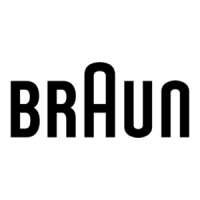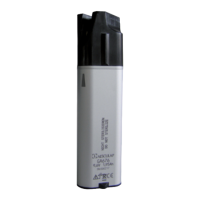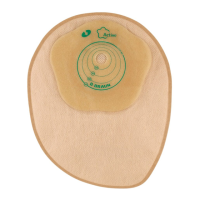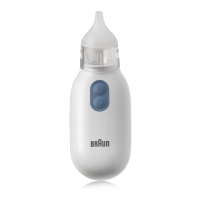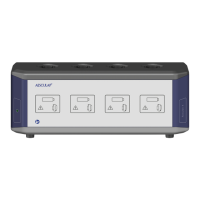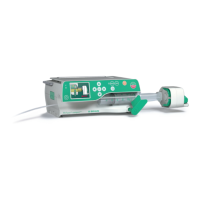en
Aesculap
®
Crown and bridge remover
1. About this document
Note
General risk factors associated with surgical procedures are not described in these instructions for use.
1.1 Scope
These instructions for use apply to the following products:
► For article-specific instructions for use as well as information on material compatibility and lifetime see B. Braun
eIFU at eifu.bbraun.com
1.2 Safety messages
Safety messages make clear the dangers to patient, user and/or product that could arise during the use of the prod-
uct. Safety messages are labeled as follows:
WARNING
Indicates a possible threat of danger. If not avoided, minor or moderate injury may result.
CAUTION
Indicates a possible threat of material damage. If not avoided, the product may be damaged.
2. Clinical use
2.1 Areas of use and limitations of use
2.1.1 Intended use
Crown and bridge removers are used to remove bridges and crowns in dentistry.
2.1.2 Indications
Note
The manufacturer is not responsible for any use of the product against the specified indications and/or the described
applications.
For indications, see Intended use.
2.1.3 Contraindications
No known contraindications.
2.2 Safety information
2.2.1 Clinical user
General safety information
To prevent damage caused by improper setup or operation, and to not compromise the manufacturer warranty and
liability:
► Use the product only according to these instructions for use.
► Follow the safety and maintenance instructions.
► Ensure that the product and its accessories are operated and used only by persons with the requisite training,
knowledge and experience.
► Store any new or unused products in a dry, clean, and safe place.
► Prior to use, check that the product is in good working order.
► Keep the instructions for use accessible for the user.
Note
The user is obligated to report all severe events in connection with the product to the manufacturer and the responsi-
ble authorities of the state in which the user is located.
Notes on surgical procedures
It is the user's responsibility to ensure that the surgical procedure is performed correctly.
Appropriate clinical training as well as a theoretical and practical proficiency of all the required operating tech-
niques, including the use of this product, are prerequisites for the successful use of this product.
The user is required to obtain information from the manufacturer if there is an unclear preoperative situation regard-
ing the use of the product.
2.2.2 Sterility
The product is delivered in an unsterile condition.
► Clean the new product after removing its transport packaging and prior to its initial sterilization.
2.3 Application
WARNING
Risk of injury and/or malfunction!
► Prior to each use, inspect the product for loose, bent, broken, cracked, worn, or fractured components.
► Always carry out a function test prior to each use of the product.
3. Validated reprocessing procedure
3.1 General safety instructions
Note
Adhere to national statutory regulations, national and international standards and directives, and local, clinical
hygiene instructions for sterile processing.
Note
For patients with Creutzfeldt-Jakob disease (CJD), suspected CJD or possible variants of CJD, observe the relevant
national regulations concerning the reprocessing of products.
Note
Mechanical reprocessing should be favored over manual cleaning as it gives better and more reliable results.
Note
Successful processing of this medical device can only be ensured if the processing method is first validated. The oper-
ator/sterile processing technician is responsible for this.
Note
If there is no final sterilization, then a virucidal disinfectant must be used.
Note
For up-to-date information about reprocessing and material compatibility, see B. Braun eIFU at eifu.bbraun.com
The validated steam sterilization procedure was carried out in the Aesculap sterile container system.
3.2 General information
Dried or affixed surgical residues can make cleaning more difficult or ineffective and lead to corrosion. Therefore the
time interval between application and processing should not exceed 6 h; also, neither fixating pre-cleaning temper-
atures >45 °C nor fixating disinfecting agents (active ingredient: aldehydes/alcohols) should be used.
Excessive measures of neutralizing agents or basic cleaners may result in a chemical attack and/or to fading and the
laser marking becoming unreadable visually or by machine for stainless steel.
Residues containing chlorine or chlorides e.g. in surgical residues, medicines, saline solutions and in the service water
used for cleaning, disinfection and sterilization will cause corrosion damage (pitting, stress corrosion) and result in
the destruction of stainless steel products. These must be removed by rinsing thoroughly with demineralized water
and then drying.
Additional drying, if necessary.
Only process chemicals that have been tested and approved (e.g. VAH or FDA approval or CE mark) and which are
compatible with the product’s materials according to the chemical manufacturers’ recommendations may be used
for processing the product. All the chemical manufacturer's application specifications must be strictly observed. Fail-
ure to do so can result in the following problems:
■ Optical changes of materials, e.g. fading or discoloration of titanium or aluminum. For aluminum, the applica-
tion/process solution only needs to be of pH >8 to cause visible surface changes.
■ Material damage such as corrosion, cracks, fracturing, premature aging or swelling.
► Do not use metal cleaning brushes or other abrasives that would damage the product surfaces and could cause
corrosion.
► Further detailed advice on hygienically safe and material-/value-preserving reprocessing can be found at www.a-
k-i.org, link to "AKI-Brochures", "Red brochure".
3.3 Reusable products
Influences of the reprocessing which lead to damage to the product are not known.
A careful visual and functional inspection before the next use is the best opportunity to recognize a product that is
no longer functional, see Inspection.
3.4 Preparations at the place of use
► If applicable, rinse non-visible surfaces preferably with deionized water, with a disposable syringe for example.
► Remove any visible surgical residues to the extent possible with a damp, lint-free cloth.
► Transport the dry product in a sealed waste container for cleaning and disinfection within 6 hours.
3.5 Preparing for cleaning
► Unscrew attachment from handle prior to cleaning.
3.6 Cleaning/Disinfection
3.6.1 Product-specific safety information on the reprocessing method
Damage to or destruction of the product due to inappropriate cleaning/disinfecting agents and/or excessive temper-
atures!
► Following the manufacturer's instructions, use cleaning and disinfecting agents
– that are approved for high-grade steel,
– that do not attack softeners (e.g., in silicone).
► Observe specifications regarding concentration, temperature and exposure time.
► Do not exceed the maximum allowable disinfection temperature of 95 °C.
► Use suitable cleaning/disinfecting agents if the product is disposed of in a wet condition. To prevent foaming and
degradation of the efficacy of the process chemicals: prior to mechanical cleaning and disinfection, rinse the
product thoroughly with running water
3.6.2 Validated cleaning and disinfection procedure
Art. no. Description
DP770R Crown and bridge remover set, consisting of DP781R, DP783R, DP784R and DP787R
DP781R Crown and bridge remover handle
DP783R Attachment for crown and bridge remover
DP784R Attachment for crown and bridge remover
DP787R Attachment for crown and bridge remover
Validated procedure Specific requirements Reference
Manual cleaning with immersion
disinfection
■ All products
■ Suitable cleaning brush
■ Disposable syringe 20 ml
■ Drying phase: Use a lint-free
cloth or medical compressed air
Chapter Manual cleaning/disinfec-
tion and subsection:
■ Chapter Manual cleaning with
immersion disinfection
Mechanical alkaline cleaning and
thermal disinfection
■ DP783R
■ DP784R
■ DP787R
■ Place the product on a tray that
is suitable for cleaning (avoid
rinsing blind spots).
Chapter Mechanical cleaning/dis-
infection and subsection:
■ Chapter Mechanical alkaline
cleaning and thermal disinfect-
ing
Manual pre-cleaning with brush
and subsequent mechanical alka-
line cleaning and thermal disinfec-
tion
■ DP781R
■ Suitable cleaning brush
■ Disposable syringe 20 ml
■ Place the product on a tray that
is suitable for cleaning (avoid
rinsing blind spots).
Chapter Mechanical cleaning/dis-
infection with manual pre-clean-
ing and subsection:
■ Chapter Manual pre-cleaning
with a brush
■ Chapter Mechanical alkaline
cleaning and thermal disinfect-
ing

